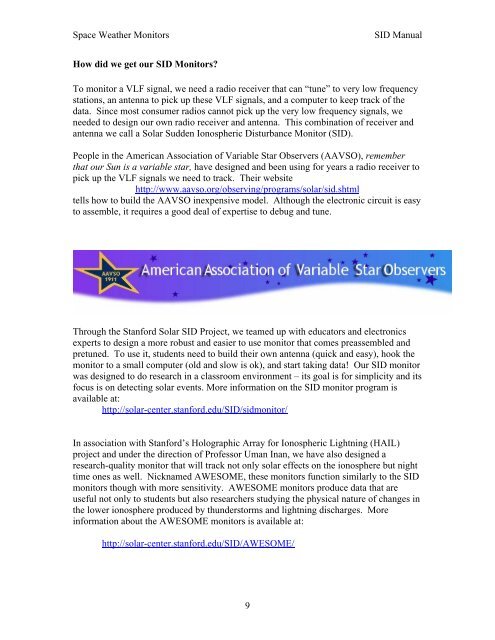Space Weather Monitors SID Users Manual - Stanford Solar Center ...
Space Weather Monitors SID Users Manual - Stanford Solar Center ...
Space Weather Monitors SID Users Manual - Stanford Solar Center ...
You also want an ePaper? Increase the reach of your titles
YUMPU automatically turns print PDFs into web optimized ePapers that Google loves.
<strong>Space</strong> <strong>Weather</strong> <strong>Monitors</strong> <strong>SID</strong> <strong>Manual</strong><br />
How did we get our <strong>SID</strong> <strong>Monitors</strong>?<br />
To monitor a VLF signal, we need a radio receiver that can “tune” to very low frequency<br />
stations, an antenna to pick up these VLF signals, and a computer to keep track of the<br />
data. Since most consumer radios cannot pick up the very low frequency signals, we<br />
needed to design our own radio receiver and antenna. This combination of receiver and<br />
antenna we call a <strong>Solar</strong> Sudden Ionospheric Disturbance Monitor (<strong>SID</strong>).<br />
People in the American Association of Variable Star Observers (AAVSO), remember<br />
that our Sun is a variable star, have designed and been using for years a radio receiver to<br />
pick up the VLF signals we need to track. Their website<br />
http://www.aavso.org/observing/programs/solar/sid.shtml<br />
tells how to build the AAVSO inexpensive model. Although the electronic circuit is easy<br />
to assemble, it requires a good deal of expertise to debug and tune.<br />
Through the <strong>Stanford</strong> <strong>Solar</strong> <strong>SID</strong> Project, we teamed up with educators and electronics<br />
experts to design a more robust and easier to use monitor that comes preassembled and<br />
pretuned. To use it, students need to build their own antenna (quick and easy), hook the<br />
monitor to a small computer (old and slow is ok), and start taking data! Our <strong>SID</strong> monitor<br />
was designed to do research in a classroom environment – its goal is for simplicity and its<br />
focus is on detecting solar events. More information on the <strong>SID</strong> monitor program is<br />
available at:<br />
http://solar-center.stanford.edu/<strong>SID</strong>/sidmonitor/<br />
In association with <strong>Stanford</strong>’s Holographic Array for Ionospheric Lightning (HAIL)<br />
project and under the direction of Professor Uman Inan, we have also designed a<br />
research-quality monitor that will track not only solar effects on the ionosphere but night<br />
time ones as well. Nicknamed AWESOME, these monitors function similarly to the <strong>SID</strong><br />
monitors though with more sensitivity. AWESOME monitors produce data that are<br />
useful not only to students but also researchers studying the physical nature of changes in<br />
the lower ionosphere produced by thunderstorms and lightning discharges. More<br />
information about the AWESOME monitors is available at:<br />
http://solar-center.stanford.edu/<strong>SID</strong>/AWESOME/<br />
9



